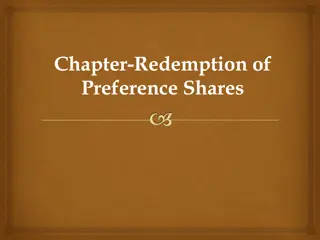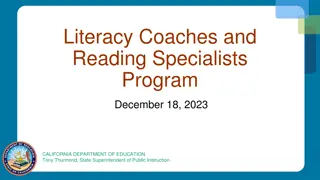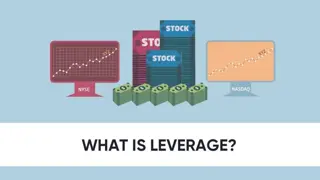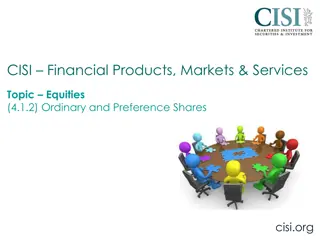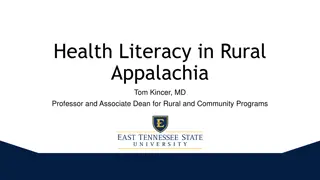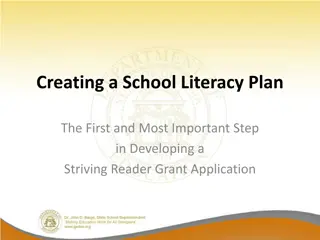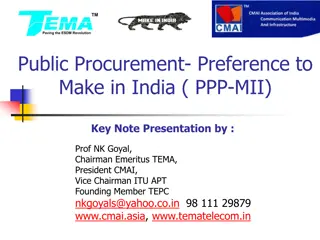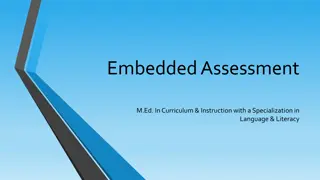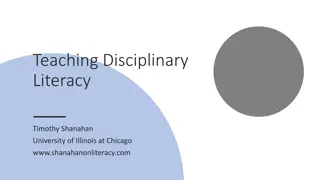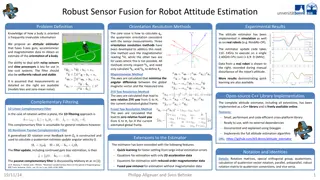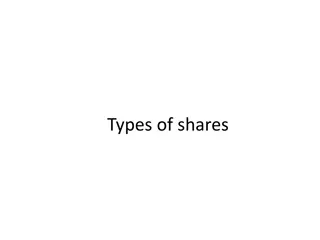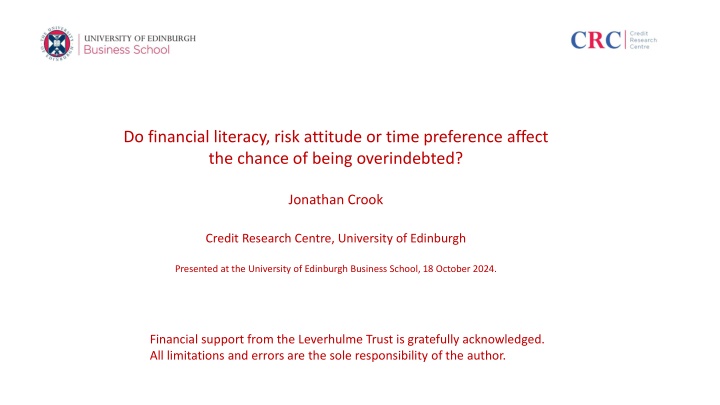
Impact of Financial Literacy, Risk Attitude, and Time Preference on Overindebtedness
This study investigates how financial literacy, risk attitude, and time preference influence the likelihood of individuals being overindebted. It delves into empirical indicators of overindebtedness, explores the relationship between financial behaviors and debt burden, and provides valuable insights into managing debt effectively.
Download Presentation

Please find below an Image/Link to download the presentation.
The content on the website is provided AS IS for your information and personal use only. It may not be sold, licensed, or shared on other websites without obtaining consent from the author. If you encounter any issues during the download, it is possible that the publisher has removed the file from their server.
You are allowed to download the files provided on this website for personal or commercial use, subject to the condition that they are used lawfully. All files are the property of their respective owners.
The content on the website is provided AS IS for your information and personal use only. It may not be sold, licensed, or shared on other websites without obtaining consent from the author.
E N D
Presentation Transcript
Do financial literacy, risk attitude or time preference affect the chance of being overindebted? Jonathan Crook Credit Research Centre, University of Edinburgh Presented at the University of Edinburgh Business School, 18 October 2024. Financial support from the Leverhulme Trust is gratefully acknowledged. All limitations and errors are the sole responsibility of the author.
Some Statistics bills and credit card commitments a heavy burden or they had fallen behind by 3 months or more with payments. (Debt Justice 2024). February 2024: 23% of survey respondents found keeping up with domestic rose from 8% in 2017 to 11% in 2023 (FCA 2023). Financial Lives Survey: percentage of adults in UK in financial difficulty February 2024 than in February 2023 (The Insolvency Service 2024). In England and Wales number of individual insolvences was 23% higher in
Aim and Structure Aim Introduction Literature Data Methodology Results Conclusions
Contributions . First study to investigate directly the relationships between being overindebted and risk attitude time preference rate We explore the effects of financial literacy with a much larger sample than previous literature Unlike much literature we make inferences about the adult population Largest recent study on overindebtedness for GB for over 12 years
Empirical Household or Personal Indicators of Overindebtedness No commonly accepted definition EC (2014) : A HH is overindebted if, on an ongoing basis it finds it difficult to pay its commitments including meeting payments for any type of debt or the payments of rent, utility or household bills. Indicator Group Example Debt Service Ratios (DSR) Individual spends > X% of (gross/net ) monthly income on total borrowing repayments (for secured and unsecured loans) (X typically = 50%) Individual spends >X% of (gross/net) monthly income on secured loans (X typically = 25%, 30%, 50%) Affordability Borrowing repayments takes the Individual below the poverty line Delinquency Individual is > A months in arrears on credit commitments or bills (A typically =2) # Loans If individual has more that Z credit commitments (Z typically =4) Perception of debt burden Individual reports repayments are a heavy burden Individual reports difficulty in paying unexpected bills Adapted from D Alessio & Lezzi (2013). Weaknesses with all.
Literature: Permanent Income Hypothesis 1 LC-PIH: Individual maximises expected discounted utility from consumption with inter-temporarily separable preferences, uncertain income, time preference rate ? equal to interest rate (r) ?? ?.? = 1 where = (1 + ?) 1,? = (1 + ?). Without credit constraints intertemporal budget constraint is: ??= ?.?? 1+ ?? ??. In general, optimality condition: ? ?? = ??? ??+1 ??. If ? < 0 there is a demand for debt. If income is expected to increase reduces savings or borrows. Borrow Repay C Y Age
Literature: Permanent Income Hypothesis 2 In the PIH: PV expected consumption = PV expected income and expected repayments are taken into account when choosing consumption in each period. In PIH there is no expected overindebtedness If are unexpected reductions in income and as a result permanent income falls then expected permanent income may be insufficient to pay current and future debts so consumption would be reduced and overindebtedness occurs. Same if unexpected increases in consumption.
Literature: Unexpected shocks Causes of unexpected income shocks: poor health, loss of job, relationship breakdown, price inflation exceeding nominal income inflation, loss of capital income, unexpected increase in cost of servicing debt. Similarly unexpected consumption increases can increase debt/assets ratio. Possible causes of unexpected consumption increases: Poor health Physical capital (appliances, car ) breakdown Debt relative to assets may increase for other reasons
Literature: Approaches outside of the PIH 1 Hyperbolic discount factors (Ainslie (1975), Laibson (1997), Laibson et al (2007)) At time t adopts discount rate between t and t+1 of ?1 and when t+1 arrives adopts the discount rate ?2 (?1 ?2) Niave individual (Strotz (1955-56) Pollack (1968)): With high disco rate between t and t+1, has high consumption in t and high borrowing, but when t+1 arrives she realises this is not optimal (Meier & Sprenger (2007)) Sophisticated individual (O Donohue & Rabin (1999), Fang & Silverman (2009), Laibson (2007) ): At t individual realises current disco rate (?1) is present day biased and commits to assume the long-term disco rate(?2) applies, so borrows less than niave hyperbolic discounter. Witmann & Paulus (2018) review empirical studies impulsive individuals adopt higher subjective discount rates than non-impulsive people. Martin & Potts (2009) impulsive individuals make decisions with higher risk outcomes than less impulsive people - so would expect impulsive people would borrow larger amounts with greater risk of inability to repay than less impulsive individuals. Evidence Much evidence that individuals adopt hyperbolic discount factors (Ainslie (1992), Cohen (2020), Laibson et al (2007)) Some studies did not find a relationship between discount rate and amounts of debt held: Harrison (2002) Meier & Sprenger (2007) Gathergood (2012). Some studies have found a relationship between present bias and debt balances: Meier & Sprenger (2010), Meier & Spenger (2007) Frigerio et al (2020) meta-analysis and noted positive relationship between impulsiveness and debt held or degree debt was unmanageable.
Literature: Approaches outside the PIH 2 Financial literacy PIH assumes individuals act as if have sufficient knowledge to make financially optimising decisions. In practice: unlikely. Evidence Gathergood (2012): correct answers to 2 out of 3 questions negatively related to being one month but not 3 months behind (UK) Lusardi & Tufano (2015): loose relationship.(US) French & McKillop (2016) : better numeracy and poorer money management skills were causes of high debt: income ratios (NI) Hamid & Loke (2021): money management skills and financial literacy were positively associated with repaying credit card debt in full (Malaysia). Kurowski (2021) financial knowledge negatively related to saying had too much debt or repayment difficulties (Poland) Weaknesses: Omit possibility that the measure of overindebtedness may be low or zero because the respondent does not have debt Few control for risk attitude or discount rate.
Literature: Approaches outside the PIH 2 Attitude towards Risk Traditional expected utility theory: choose action with highest expected utility. If marginal utility of consumption declines at higher levels of consumption risk averse So less likely to take actions with risky outcomes than a risk neutral person (expected utility is lower for risk averse person) Borrowing is risky so risk aversion person less willing to borrow than risk neutral person. Counterviews: If individual expects a negative income shock a risk averse person may take very large amounts of debt (so being overindebted) because she is consumption smoothing. (Lagomarsono & Spiganti (2023)) Prospect theory: Individuals are risk averse to potential gains but risk seekers concerning potential losses. (Kahneman & Tversky (1979)) People typically prefer A: 600 p=1 to B: { 1200 p=0.5 or 0 p=0.5} BUT prefer C: { -1200 p=0.5 or 0 p=0,5} to D: -600 p=1 So more likely to accept risk of losses so more likely to take on excessive debt than under expected utility hypothesis. Evidence Little relationship Blanquez et al (2020), Meyll & Pauls (2019)) Positive relationship Nagano & Yeom (2014) But in all 3 studies the measures of risk aversion are problematic.
Data Round 7 of Wealth and Assets Survey (EUL version) ONS (only round with financial literacy questions) Data collected at household and individual level Respondents lived in England, Wales & Scotland (south of the Caledonian Canal) Respondents were aged 16+ and not in FT education. Wealthy are oversampled. had non-positive net income, if any variables had a missing value. Deleted cases: where interview was not in person, if less than a full or partial interview, some extreme values, Consider only overindebtedness on cards, credit agreements, overdrafts, loans and bill payments (not mortgages). WAS is good choice because: Can compute several different measures of overindebtedness (many studies use only one) Is largest UK survey that allows this (sample sizes we use are dramatically larger than any of the published studies) Sample selected to be representative of population of GB Is the only recent survey that includes financial literacy Has large number of relevant socio-demographics to act as controls.
Measures of Overindebtedness Burden Now thinking about the mortgage or loans secured on your property in addition to these payments, to what extent is keeping up with all of the repayments and interest payments a financial burden to your household? A heavy burden/somewhat of a burden/ Or not a problem at all ? Missed 2 Have you been able to keep up with the repayments for the instalments on [this catalogue/these catalogues] or are you 2 or more consecutive payments behind? Debt service ratio (DSR) 30% Computed as: If (total repayments / net income) > 30%
Questions on risk aversion, discount rate and financial literacy Financial Literacy 1. If the inflation rate is 5% and the interest rate you get on your savings is 3%, will your savings have more, less or the same amount of buying power in a year s time? 2. SHOWCARD: standard bank statement. Looking at this example of a bank statement, please can you tell me how much money was in the account at the end of February? 3. Suppose you put 100 into a savings account with a guaranteed interest rate of 2% per year. You don t make any further payments into this account and you don t withdraw any money. How much money would be in the account at the end of the first year, once the interest payment is made? Discount Rate If you had a choice of receiving a thousand pounds today and one thousand one hundred pounds in 12 months time, which would you choose? Risk aversion If you had a choice between a guaranteed payment of one thousand pounds and a one in five chance of winning ten thousand pounds, which would you choose?
Control variables From the literature: Age 15-24 Age 25-34 Age 35-44 Age 45-54 Age 55-64 Male Single Divorced or separated Has undergrad degree Has dependent children. Owns or rents accommodation Is unemployed Is self employed Log(real net income) Real total benefits received Repayments/net income Log(real net worth) Has bad health Has long-standing illness
Econometric Strategy Questions on burden of repayments and on whether missed two payments asked only to those with debt. Observations may be MNAR because those without debt may have been rejected by lenders because lender expected applicant to become overindebted or did not apply because thought would be unable to repay. Used Heckman sample selection estimators. Sample selection equation: whether has debt or not. Assume probit model. Implement ML estimators as in Van de Ven & Van Praag (1981). Identification Strategy: Being a single parent expected to increase demand for debt, but conditional on other characteristics is not expected to affect whether holds so much debt that feels overindebted. Having qualifications other than an undergraduate degree expected to affect whether has debt but not whether is overindebted. Neither significant in overindebtedness probit but highly significant in has debt equation.
Summary statistics Total Those who have debt Find payts. a burden Do not find a burden # in sample 25,330 3,587 14,029 Implied population size 37,324,397 6,905,842 18,493,174 Time pref rate (% preferring 1000 today) 71.04 81.04 64.61 Risk attitude (% taking guaranteed 1000) 81.13 81.98 78.55 Fin Lit 1: Understanding real interest (%correct) 75.24 70.06 82.23 Fin Lit 2: Understanding bank statement (% correct) 85.10 85.23 88.83 Fin Lit 3: Understanding interest (% correct) 81.15 78.51 87.40 Have debt (%) 68.05 Cases are weighted by population sampling weights. Sample consists of all individuals who were interviewed in person and for whom there was a full or partial interview and for whom there were no missing values for any of the variables in the list and who had repayments/net income of less than the 99.75th percentile.
Overindebtedness models with risk attitude, discount rate and literacy Repayments are a heavy or somewhat heavy burden Missed two consecutive payments Debt-service ratio > 30% Time preference rate 0.329** 0.224* 0.267** (0.028) (0.113) (0.036) Risk attitude 0.151** -0.040 0.023 (0.031) (0.105) (0.039) FL1: Real interest understanding -0.047 -0.117 0.024 (0.033) (0.101) (0.044) FL2: Bank statement understanding -0.038 0.105 0.075 (0.039) (0.138) (0.053) FL3: Interest understanding -0.060 -0.070 0.042 (0.037) (0.113) (0.051) No observations 25,330 24,210 25,336 No selected 17,616 10,115 17,088 No not selected 7,714 14,095 8,248 Wald Chi-squared 2,495** 205** 676** Rho (e1,e2) 0.331** 0.107 0.272 Controls Yes Yes Yes Sample seln equation Yes Yes Yes
Extensions: Risk attitude Evidence suggests that degree of risk aversion is related to wealth: Many studies find higher wealth associated with lower risk aversion: Chiappori & Pailla (2011), Fang et al 2011, Guiso & Paiella (2008) Meeuwis (2022). One finds no relationship Brunnermeier & Nagel (2008). If this holds then an individual with high wealth may not regard the utility gain of 10k relative to the utility loss of 1k as being as large as would a person with less wealth. We model effect of choosing guaranteed sum rather than the gamble according to the share of an individual s net income that the max outcome ( 10k) would make as follows Compute the first 3 quartiles of the distribution of : ??= 10,000/??? ??????? Compute ?1= 1 ?? 0 < ??< ?1 ?2= 1 ?? ?1< ??< ?2 0 ?? ?????? ?3= 1 ?? ?2< ??< ?3 0 ?? ?????? 0 ?? ?????? Replace risk covariate with: ?1 ????? , ?2 ?????, ?3 = ?????
Overindebtedness models interaction risk attitude with income quartiles Coefficients Repayments are a heavy or somewhat heavy burden Missed two consecutive payments Debt-service ratio > 30% ** Time preference rate 0.330** 0.235* 0.271** (0.028) (0.114) (0.036) First income share quartile x risk attitude -0.012 -0.051 -0.196** (0.040) (0.153) (0.052) Second income share quartile x risk attitude 0.066* -0.195 -0.115** (0.033) (0.122) (0.044) Third income share quartile x risk attitude 0.092** -0.055 0.017 (0.033) (0.109) (0.042) FL1: Real interest understanding -0.046 -0.118 0.025 (0.033) (0.102) (0.044) FL2: Bank statement understanding -0.041 0.108 0.069 (0.039) (0.139) (0.054) FL3: Interest understanding -0.059 -0.073 0.043 (0.037) (0.114) (0.052) No observations 25,330 24,210 25,336 No selected 17,616 10,115 17,088 No not selected 7,714 14,095 8,248 Wald Chi-squared 2,503** 209** 686** Rho (e1,e2) 0.324** 0.090 0.238 Controls Yes Yes Yes Sample seln equation Yes Yes Yes
Overindebtedness models interaction risk attitude with income quartiles Pr (repayts burden) Non-linear relationship x x x x Relative risk aversion Low High x x Pr (DSR>30%) x Increase from low to high x Relative risk aversion Low High
Overindebtedness and degree of financial knowledge (burden indicator) Are there systematic effects of giving the wrong answers to the financial literacy questions, in particular directions? 1) Inflation question Low level of knowledge Bank statement Interest rate: DI1 = 1 if response was more ; 0 otherwise DI2 = 1 if response was same ; 0 otherwise DI3 = 1 if response was less ; 0 otherwise DI4 = 1 if don t know or refusal ; 0 otherwise DB1=1 if overestimate; 0 otherwise DB2=1 if correct answer; 0 otherwise DB3=1 if underestimate; 0 otherwise DB4=1 if don t know or refusal; 0 otherwise DR1=1 if overestimate; 0 otherwise DR2=1 if correct answer; 0 otherwise DR3=1 if underestimate; 0 otherwise DR4=1 if don t know or refusal; 0 otherwise Estimate three probit equations, each with controls plus one set of dummies 2) Good level of knowledge Created 3 dummies each =1 if two questions answered correctly; 0 otherwise DIB=1 if inflation and bank questions both correct; DIR=1 if inflation and interest rate questions both correct; DIR=1 if bank and interest rate questions both correct; 0 otherwise 0 otherwise 0 otherwise One probit on controls plus all 3 dummies 3) Very good level of knowledge Created one dummy =1 if all three questions correct; 0 otherwise One probit on controls plus this dummy
Overindebtedness and degree of financial knowledge (burden indicator) Panel A Models with each knowledge indicator separately Real interest understanding Bank statement understanding Interest understanding D1 (more) 0.040 D1 (overestimate) -0.032 0.096 (0.065) (0.063) (0.049) D2 (same) 0.015 (0.054) D2 (correct) omitted Omitted D3 (correct) Omitted D3 (underestimate) 0.104 -0.072 (0.066) (0.086) D4 (don t know or refusal) 0.089 D4 (don t know or refusal) 0.068 0.101* (0.038) (0.058) (0.050) No observations 25,330 25,330 25,330 No selected 17,616 17,616 17,616 No not selected 7,714 7,714 7,714 Wald Chi-squared 2,416** 2,396** 2,435** Rho (e1,e2) 0.379** 0.392** 0.369** Controls Yes Yes Yes Sample seln equation Yes Yes Yes
Analysis of individual response levels for financial literacy measures (burden indicator) Panel C Very good level of knowledge Panel B Good level of knowledge Answers to all three questions correct -0.083** Both inflation and bank statement questions correct -0.041 (0.028) (0.039) Both inflation and interest questions correct -0.020 (0.039) Both bank statement and interest questions correct -0.052 No observations 25,330 (0.037 No selected 17,616 No not selected 7,714 Wald Chi-squared 2,462** Rho (e1,e2) 0.349** No observations 25,330 Controls Yes No selected 17,616 Sample seln equation Yes No not selected 7,714 Wald Chi-squared 2,500** Rho (e1,e2) 0.327** Controls Yes Sample seln equation Yes
Results for control variables Repts heavy or somewhat heavy burden Missed 2 consecutive payments DSR>30% Repts heavy or somewhat heavy burden Missed 2 consecutive payments DSR>30% Age 15-24 0.617** 1.161** -0.115 Dep children 0.395** -0.017 0.240** Age 25-34 0.913** 0.845** 0.195* Owns or rents 0.165** 0.280 0.092 Age 35-44 0.927** 0.806** 0.306* Unemployed 0.309** 0.284 0.181 Age 45-54 0.845** 0.814** 0.322** Self empl 0.086* -0.053 0.175** Age 55-64 0.575** 0.646** 0.171** Log (net inc) -0.026 -0.122 -0.141** Male 0.056** 0.167 0.065* Total benefits + ** + ** - ** Single 0.218** 0.184 -0.146** Repayts/net inc 1.235** 0.451** Divcd or sep. 0.502** 0.228 0.072 Log (net wealth) -0.076** -0.041** -0.042** Undergrad degree -0.117** -0.090 -0.012
Example of selection equation Repayments are a heavy or somewhat heavy burden Missed two consecutive payments Debt-service ratio > 30% Repayments are a heavy or somewhat heavy burden Missed two consecutive payments Debt-service ratio > 30% Age 25-54 0.159** 0.300** 0.101** Log (real net wealth) 0.015** -0.52 x 10-2 0.031** Single -0.240** -0.049 -0.274** FL1 Real interest understanding FL2 Bank statement understanding FL3 Interest understanding 0.121** 0.054* 0.137** Divorced or separated -0.089** 0.204** -0.142** 0.228** 0.162** 0.218** Single parent 0.282** 0.174** 0.215** Is self employed 0.035 0.051 0.18x10-2 0.145** 0.086** 0.156** Real net income 0.045** 0.024** 0.049** Real total benefits received -0.13 x 10-3** -0.21x 10-3** -0.16x10-3** No observations 25,330 24,210 25,336 Has undergraduate degree 0.742** 0.542** 0.748** No selected 17,616 10,115 17,088 Has qual other than degree 0.447** 0.405** 0.429** No not selected 7,714 14,095 8,248 Has dependent children -0.026 0.120** -0.043 Wald Chi-squared 2,503** 205** 676** Owns or rents accomodation 0.417** 0.291** 0.381** Rho (e1,e2) 0.324** 0.107 0.272
Conclusions Modest or basic financial knowledge have no detectable effect. Similar to Gathergood (2012), different from Lusardi & Tuffano (2015) Only those with a relatively high level of financial literacy have a lower chance of perceiving debt payments to be a burden Individuals with a basic level of financial knowledge ae more likely to hold debt than those with less knowledge. have a lower chance of a high debt : income ratio. (consistent with Lagomarsino and Spiganti (2023). There is a concave relationship between risk aversion and repayments being a perceived burden whilst less risk averse individuals hyperbolic discounters more likely to be overindebted than exponential discounters. Those with a relatively high discount rate are more likely to be overindebted on all three measures. Consistent with hypothesis that
Reference J. Crook (2024) Do Financial literacy, risk attitude or time preference affect the chance of being overindebted? Under submission.
Thank you. j.crook@ed.ac.uk

